Tao Jia
Deep learning framework for predicting stochastic take-off and die-out of early spreading
Oct 06, 2025Abstract:Large-scale outbreaks of epidemics, misinformation, or other harmful contagions pose significant threats to human society, yet the fundamental question of whether an emerging outbreak will escalate into a major epidemic or naturally die out remains largely unaddressed. This problem is challenging, partially due to inadequate data during the early stages of outbreaks and also because established models focus on average behaviors of large epidemics rather than the stochastic nature of small transmission chains. Here, we introduce the first systematic framework for forecasting whether initial transmission events will amplify into major outbreaks or fade into extinction during early stages, when intervention strategies can still be effectively implemented. Using extensive data from stochastic spreading models, we developed a deep learning framework that predicts early-stage spreading outcomes in real-time. Validation across Erd\H{o}s-R\'enyi and Barab\'asi-Albert networks with varying infectivity levels shows our method accurately forecasts stochastic spreading events well before potential outbreaks, demonstrating robust performance across different network structures and infectivity scenarios.To address the challenge of sparse data during early outbreak stages, we further propose a pretrain-finetune framework that leverages diverse simulation data for pretraining and adapts to specific scenarios through targeted fine-tuning. The pretrain-finetune framework consistently outperforms baseline models, achieving superior performance even when trained on limited scenario-specific data. To our knowledge, this work presents the first framework for predicting stochastic take-off versus die-out. This framework provides valuable insights for epidemic preparedness and public health decision-making, enabling more informed early intervention strategies.
PSNE: Efficient Spectral Sparsification Algorithms for Scaling Network Embedding
Aug 05, 2024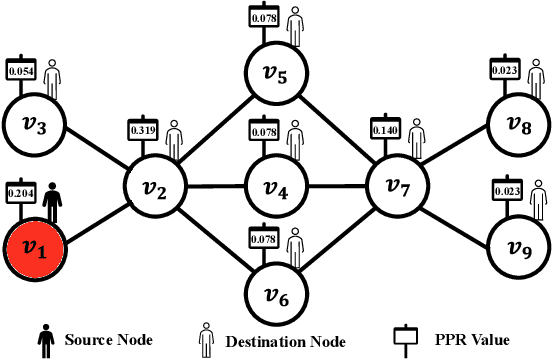


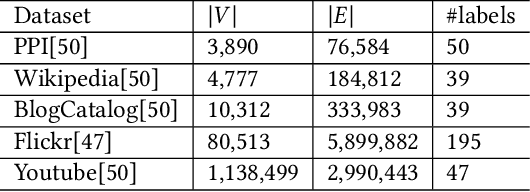
Abstract:Network embedding has numerous practical applications and has received extensive attention in graph learning, which aims at mapping vertices into a low-dimensional and continuous dense vector space by preserving the underlying structural properties of the graph. Many network embedding methods have been proposed, among which factorization of the Personalized PageRank (PPR for short) matrix has been empirically and theoretically well supported recently. However, several fundamental issues cannot be addressed. (1) Existing methods invoke a seminal Local Push subroutine to approximate \textit{a single} row or column of the PPR matrix. Thus, they have to execute $n$ ($n$ is the number of nodes) Local Push subroutines to obtain a provable PPR matrix, resulting in prohibitively high computational costs for large $n$. (2) The PPR matrix has limited power in capturing the structural similarity between vertices, leading to performance degradation. To overcome these dilemmas, we propose PSNE, an efficient spectral s\textbf{P}arsification method for \textbf{S}caling \textbf{N}etwork \textbf{E}mbedding, which can fast obtain the embedding vectors that retain strong structural similarities. Specifically, PSNE first designs a matrix polynomial sparser to accelerate the calculation of the PPR matrix, which has a theoretical guarantee in terms of the Frobenius norm. Subsequently, PSNE proposes a simple but effective multiple-perspective strategy to enhance further the representation power of the obtained approximate PPR matrix. Finally, PSNE applies a randomized singular value decomposition algorithm on the sparse and multiple-perspective PPR matrix to get the target embedding vectors. Experimental evaluation of real-world and synthetic datasets shows that our solutions are indeed more efficient, effective, and scalable compared with ten competitors.
Collaborative Team Recognition: A Core Plus Extension Structure
Jun 07, 2024



Abstract:Scientific collaboration is a significant behavior in knowledge creation and idea exchange. To tackle large and complex research questions, a trend of team formation has been observed in recent decades. In this study, we focus on recognizing collaborative teams and exploring inner patterns using scholarly big graph data. We propose a collaborative team recognition (CORE) model with a "core + extension" team structure to recognize collaborative teams in large academic networks. In CORE, we combine an effective evaluation index called the collaboration intensity index with a series of structural features to recognize collaborative teams in which members are in close collaboration relationships. Then, CORE is used to guide the core team members to their extension members. CORE can also serve as the foundation for team-based research. The simulation results indicate that CORE reveals inner patterns of scientific collaboration: senior scholars have broad collaborative relationships and fixed collaboration patterns, which are the underlying mechanisms of team assembly. The experimental results demonstrate that CORE is promising compared with state-of-the-art methods.
A performance characteristic curve for model evaluation: the application in information diffusion prediction
Sep 19, 2023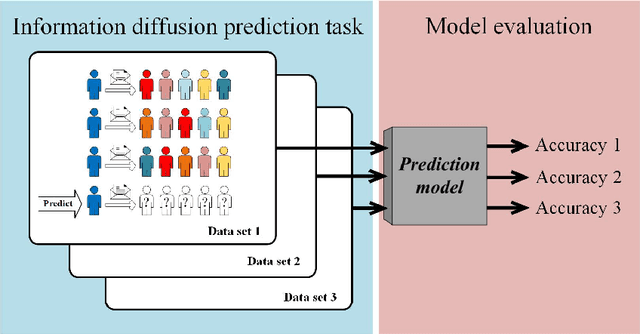



Abstract:The information diffusion prediction on social networks aims to predict future recipients of a message, with practical applications in marketing and social media. While different prediction models all claim to perform well, general frameworks for performance evaluation remain limited. Here, we aim to identify a performance characteristic curve for a model, which captures its performance on tasks of different complexity. We propose a metric based on information entropy to quantify the randomness in diffusion data, then identify a scaling pattern between the randomness and the prediction accuracy of the model. Data points in the patterns by different sequence lengths, system sizes, and randomness all collapse into a single curve, capturing a model's inherent capability of making correct predictions against increased uncertainty. Given that this curve has such important properties that it can be used to evaluate the model, we define it as the performance characteristic curve of the model. The validity of the curve is tested by three prediction models in the same family, reaching conclusions in line with existing studies. Also, the curve is successfully applied to evaluate two distinct models from the literature. Our work reveals a pattern underlying the data randomness and prediction accuracy. The performance characteristic curve provides a new way to systematically evaluate models' performance, and sheds light on future studies on other frameworks for model evaluation.
Multi-feature concatenation and multi-classifier stacking: an interpretable and generalizable machine learning method for MDD discrimination with rsfMRI
Aug 18, 2023Abstract:Major depressive disorder is a serious and heterogeneous psychiatric disorder that needs accurate diagnosis. Resting-state functional MRI (rsfMRI), which captures multiple perspectives on brain structure, function, and connectivity, is increasingly applied in the diagnosis and pathological research of mental diseases. Different machine learning algorithms are then developed to exploit the rich information in rsfMRI and discriminate MDD patients from normal controls. Despite recent advances reported, the discrimination accuracy has room for further improvement. The generalizability and interpretability of the method are not sufficiently addressed either. Here, we propose a machine learning method (MFMC) for MDD discrimination by concatenating multiple features and stacking multiple classifiers. MFMC is tested on the REST-meta-MDD data set that contains 2428 subjects collected from 25 different sites. MFMC yields 96.9% MDD discrimination accuracy, demonstrating a significant improvement over existing methods. In addition, the generalizability of MFMC is validated by the good performance when the training and testing subjects are from independent sites. The use of XGBoost as the meta classifier allows us to probe the decision process of MFMC. We identify 13 feature values related to 9 brain regions including the posterior cingulate gyrus, superior frontal gyrus orbital part, and angular gyrus, which contribute most to the classification and also demonstrate significant differences at the group level. The use of these 13 feature values alone can reach 87% of MFMC's full performance when taking all feature values. These features may serve as clinically useful diagnostic and prognostic biomarkers for mental disorders in the future.
An Interpretable Loan Credit Evaluation Method Based on Rule Representation Learner
Apr 03, 2023



Abstract:The interpretability of model has become one of the obstacles to its wide application in the high-stake fields. The usual way to obtain interpretability is to build a black-box first and then explain it using the post-hoc methods. However, the explanations provided by the post-hoc method are not always reliable. Instead, we design an intrinsically interpretable model based on RRL(Rule Representation Learner) for the Lending Club dataset. Specifically, features can be divided into three categories according to their characteristics of themselves and build three sub-networks respectively, each of which is similar to a neural network with a single hidden layer but can be equivalently converted into a set of rules. During the training, we learned tricks from previous research to effectively train binary weights. Finally, our model is compared with the tree-based model. The results show that our model is much better than the interpretable decision tree in performance and close to other black-box, which is of practical significance to both financial institutions and borrowers. More importantly, our model is used to test the correctness of the explanations generated by the post-hoc method, the results show that the post-hoc method is not always reliable.
Author Name Disambiguation via Heterogeneous Network Embedding from Structural and Semantic Perspectives
Dec 24, 2022Abstract:Name ambiguity is common in academic digital libraries, such as multiple authors having the same name. This creates challenges for academic data management and analysis, thus name disambiguation becomes necessary. The procedure of name disambiguation is to divide publications with the same name into different groups, each group belonging to a unique author. A large amount of attribute information in publications makes traditional methods fall into the quagmire of feature selection. These methods always select attributes artificially and equally, which usually causes a negative impact on accuracy. The proposed method is mainly based on representation learning for heterogeneous networks and clustering and exploits the self-attention technology to solve the problem. The presentation of publications is a synthesis of structural and semantic representations. The structural representation is obtained by meta-path-based sampling and a skip-gram-based embedding method, and meta-path level attention is introduced to automatically learn the weight of each feature. The semantic representation is generated using NLP tools. Our proposal performs better in terms of name disambiguation accuracy compared with baselines and the ablation experiments demonstrate the improvement by feature selection and the meta-path level attention in our method. The experimental results show the superiority of our new method for capturing the most attributes from publications and reducing the impact of redundant information.
Scalable and Effective Conductance-based Graph Clustering
Nov 22, 2022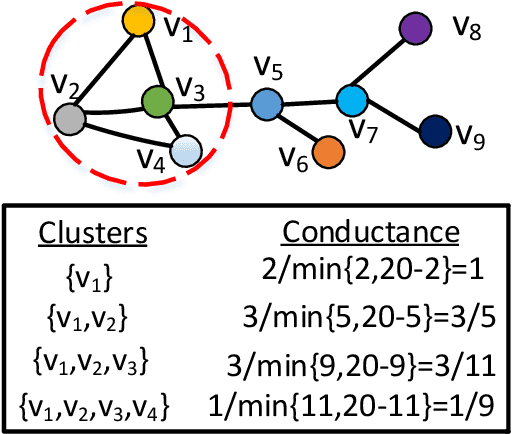


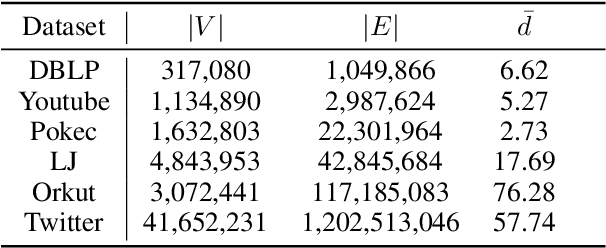
Abstract:Conductance-based graph clustering has been recognized as a fundamental operator in numerous graph analysis applications. Despite the significant success of conductance-based graph clustering, existing algorithms are either hard to obtain satisfactory clustering qualities, or have high time and space complexity to achieve provable clustering qualities. To overcome these limitations, we devise a powerful \textit{peeling}-based graph clustering framework \textit{PCon}. We show that many existing solutions can be reduced to our framework. Namely, they first define a score function for each vertex, then iteratively remove the vertex with the smallest score. Finally, they output the result with the smallest conductance during the peeling process. Based on our framework, we propose two novel algorithms \textit{PCon\_core} and \emph{PCon\_de} with linear time and space complexity, which can efficiently and effectively identify clusters from massive graphs with more than a few billion edges. Surprisingly, we prove that \emph{PCon\_de} can identify clusters with near-constant approximation ratio, resulting in an important theoretical improvement over the well-known quadratic Cheeger bound. Empirical results on real-life and synthetic datasets show that our algorithms can achieve 5$\sim$42 times speedup with a high clustering accuracy, while using 1.4$\sim$7.8 times less memory than the baseline algorithms.
Significant Ties Graph Neural Networks for Continuous-Time Temporal Networks Modeling
Nov 12, 2022



Abstract:Temporal networks are suitable for modeling complex evolving systems. It has a wide range of applications, such as social network analysis, recommender systems, and epidemiology. Recently, modeling such dynamic systems has drawn great attention in many domains. However, most existing approaches resort to taking discrete snapshots of the temporal networks and modeling all events with equal importance. This paper proposes Significant Ties Graph Neural Networks (STGNN), a novel framework that captures and describes significant ties. To better model the diversity of interactions, STGNN introduces a novel aggregation mechanism to organize the most significant historical neighbors' information and adaptively obtain the significance of node pairs. Experimental results on four real networks demonstrate the effectiveness of the proposed framework.
Multi-channel Nuclear Norm Minus Frobenius Norm Minimization for Color Image Denoising
Sep 16, 2022



Abstract:Color image denoising is frequently encountered in various image processing and computer vision tasks. One traditional strategy is to convert the RGB image to a less correlated color space and denoise each channel of the new space separately. However, such a strategy can not fully exploit the correlated information between channels and is inadequate to obtain satisfactory results. To address this issue, this paper proposes a new multi-channel optimization model for color image denoising under the nuclear norm minus Frobenius norm minimization framework. Specifically, based on the block-matching, the color image is decomposed into overlapping RGB patches. For each patch, we stack its similar neighbors to form the corresponding patch matrix. The proposed model is performed on the patch matrix to recover its noise-free version. During the recovery process, a) a weight matrix is introduced to fully utilize the noise difference between channels; b) the singular values are shrunk adaptively without additionally assigning weights. With them, the proposed model can achieve promising results while keeping simplicity. To solve the proposed model, an accurate and effective algorithm is built based on the alternating direction method of multipliers framework. The solution of each updating step can be analytically expressed in closed-from. Rigorous theoretical analysis proves the solution sequences generated by the proposed algorithm converge to their respective stationary points. Experimental results on both synthetic and real noise datasets demonstrate the proposed model outperforms state-of-the-art models.
 Add to Chrome
Add to Chrome Add to Firefox
Add to Firefox Add to Edge
Add to Edge